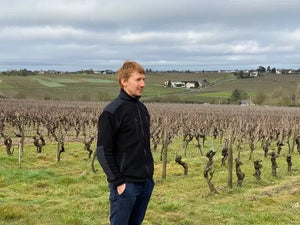Blog » Natural Wine
-
Dolomite Dynamics: Foradori Teroldego & Singular Whites
The magical wines from the Foradori estate in Trentino's Dolomite Mountains have been well-documented here before, and I find an added layer of refinement and precision with each release. If you're curious about Italy's extreme alpine setting, Foradori is where I recommend you turn first.
Teroldego is an esoteric variety that opens with dark plum and licorice, followed by softer floral and herbaceous qualities, and finishes with a finely pronounced minerality. From the first sip to the last, Elisabetta's wines are constantly changing and fascinating to no end. The entry-level teroldego ages in neutral barrels and cement tanks while the old-vine, riserva-level "Granato ages in old foudres.
Elisabetta's father unexpectedly passed away while she was still in enology school, and after graduating, in 1984, she was thrust into harvest and production thereafter. Though her winemaking garnered awards in the 90s, the wines came into their own when she adopted biodynamic principles, eliminated lab yeasts, lowered sulfur additions, and included riper stems in the ferments. Visits with Giusto Occhipinti of COS introduced her to the use of clay amphora for aging. -
Bona Fide Naturalist: Werlitsch vom Opok
Wineries like Werlitsch in Austria's Styria region perpetuate those dreamy biodynamic farm vibes we've seen springing up in Eastern Europe. Sure, the scenes are breathtaking and make for a good selling point, but what winemaker Ewald Tscheppe produces from his opok-rich soils restores our faith in the far reaches of natural wine.
Our team once blind-tasted the Ex Vero I together. It had a matchstick quality on the nose, followed by white florals, fresh citrus, coconut milk-like texture, and electric acidity on the palate. Still, the wine's focal point was its lively energy and slightly waxy texture. I guessed it was from the Jura, thinking it had a Burgundy gone rogue feeling, but it turned out to be a blend of Sauvignon Blanc and Morillon (aka Chardonnay). Ex Vero is a three-part series showcasing the varied levels of altitude and soil composition on Werlitsch's steep hillside. These vines grow on limestone and clay soil rich in minerals and marine fossils, which locals refer to as opok. Frankly, the wines are unlike anything you'll taste from Austria or elsewhere.
Ewald and his friends discovered biodynamics while studying wine in the early 1980s. As a true devotee of the naturalist movement, he believes that nature always does it better—for him, that means gravity-flow winemaking, natural yeast, no temperature control, and no sulfur. In 2004, Ewald began to apply biodynamics to his family's estate, which also inhabits fruit trees, wild herbs, vegetables, and forests. -
Anjou Outlier: Pierre Menard's Old-Vine Sauvignon Blanc
Pierre Menard reaches cult status in Europe for his lieu-dit (single-vineyard) Chenin Blancs. Simply put, Chenin gets the prime slopes in Anjou, where schist dominates, and the flatlands may see some Sauvignon Blanc. However, Menard discovered one of the first Sauvignon Blanc parcels in this region, the tiny 1957-planted Clos de la Roche atop a slope in Faye d'Anjou.
Before tasting Laïka, one should expel any notion of what this variety delivers. Typical grapefruit and lime fade into the background—much like earth did when the first living creature, a dog named Laïka, was rocketed into space in 1957—those flavors are replaced by saffron butter, a kaleidoscope of yellow fruits, and a mineral underpinning that only Anjou's schist-laden slopes convey.
Only a few cases of Laïka enter the U.S. each year. Also, do not miss Menard's stellar Chenin Blancs in equally small quantities. While we don't focus on many sweet/dessert wines, the "Cosmos" Coteaux du Layon (500 ml) blew us away. Perfect for pairing with cheese or dessert, but save the chocolate for Port!
.svg?v=162776257677185172071724397232)





